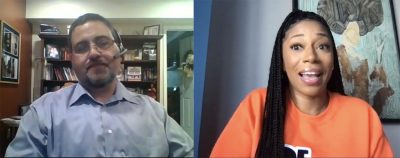Boston University’s College of Communication hosted a panel called “Innovation Beyond Isolation: Creating news content in a post-pandemic world” Wednesday which discussed journalists who have been forced to adapt to an unprecedented pandemic. Fittingly, the event took place on Zoom.

The panel featured guest speakers Ed Reed — a 1995 COM alum and deputy Florida sports editor at USA Today— and Robyn Neal, event content creator and digital host for Gannet at the USA TODAY Network. A. Sherrod Blakely, a BU lecturer and NBA contributor to Bulletin.com and Bleacher Report, moderated the panel.
In an interview, Blakely said one of the biggest challenges he faced as a reporter during the pandemic was finding stories when professional sports were on a hiatus. However, the absence of live sports allowed him to focus on longer, more in-depth projects that he had not been able to find time for previously, he said.
“For me, it was an opportunity to go through the Rolodex and start writing about stories and things that may have been on the backburner before because I was so indoctrinated with my game coverage,” he said.
Blakely was also able to develop his multimedia platform through podcasting. Following the release of Michael Jordan’s documentary “The Last Dance” last year, Blakely capitalized on its popularity and scored an interview with Danny Crawford, a former NBA referee who officiated a game where Jordan made a controversial move. This podcast was the first time Crawford publicly addressed this matter.
“That generated a good amount of attention,” Blakely said. “For me, it was an opportunity to lean on sources I’ve had for many many years … and give them a platform to speak and address some topics that they may not have been asked about before.”
The opportunity to explore unusual stories and develop new skills came up frequently during the webinar.
Content creator Neal created “28 for 28,” a piece highlighting 28 influential Black women in the sports realm in February in honor of Black History Month. At her previous position, sometimes her content pitches were not always accepted.
“At the time, [the leaders] just weren’t open to it. They didn’t want to create what I had a vision in my head for, and that wasn’t going to stop me from producing the content because, with social media, there’s an audience for everything,” Neal said at the event. “I have my own platform.”
Reed spoke about how he explored various social media outlets during the pandemic.
“You can tell stories in so many different ways,” he said. “I never thought I’d be building graphics to put up on social media. I do that now. I never thought I’d be working with video. I do that now. I never thought this wonderful Massachusetts voice would be on Twitter spaces out in the atmosphere. I do that now.”
Reed also said Zoom has been the “great equalizer” for smaller papers looking to geographically extend their reporting. With so many press conferences taking place on Zoom, reporters do not have to travel to report on out-of-state events.
Jenny Kornreich, news director at the BU student radio station WTBU and a junior in COM, has seen firsthand how Zoom has been able to benefit smaller news outlets.
“We can’t always send people x amount of miles away to go interview someone or go sit at this campaign headquarters or go to the site of a natural disaster,” she said. “We almost can never do that because we don’t have the money because we’re students … so Zoom has pretty much unlocked everywhere outside of where the [MBTA] can get us.”
During a summer fellowship with WBUR this past year, Kornreich worked as a breaking news reporter remotely from home in Wisconsin.
“It’s almost surprising now when you see an internship listing [where] you have to be there in the office, in person, like it almost doesn’t exist anymore,” Kornreich said.
However, in many ways, the pandemic has created more problems than it has solved.
Blakely said in an interview that the pandemic deprived young journalists of the opportunity to build long-term relationships with sources to interview in the future.
“If there’s one part about what we did journalistically pre-pandemic that I think everyone would like to see more of going forward, it is that dynamic,” he said. “That ability to engage and interact with sources in a more personal, face-to-face manner.”
But even with the limitations of isolation, journalists and content creators have found creative ways to connect with people and share their stories.
At the start of the pandemic, Neal launched an Instagram series called “For the Culture” in which she interviewed influential artists, athletes, activists and entertainers. Discussing the project with Blakely during the webinar, Neal said that almost all of her sourcing was developed through digital connections.
“For me, half [of] those people, I didn’t know,” she said. “But shooters shoot, and I’m a shooter, so I send DMs all day, no problem.”
The panelists agreed that the media industry and the world it covers have always evolved, and the key to keeping up is to evolve alongside them.
“I joke around with my guys [that] you adapt or die,” Reed said, “That’s been my philosophy in journalism … I started off at BU with wax and paper and boards and whiteboards, and as times change, you have to change with it. I see so much good in it.”























































































































